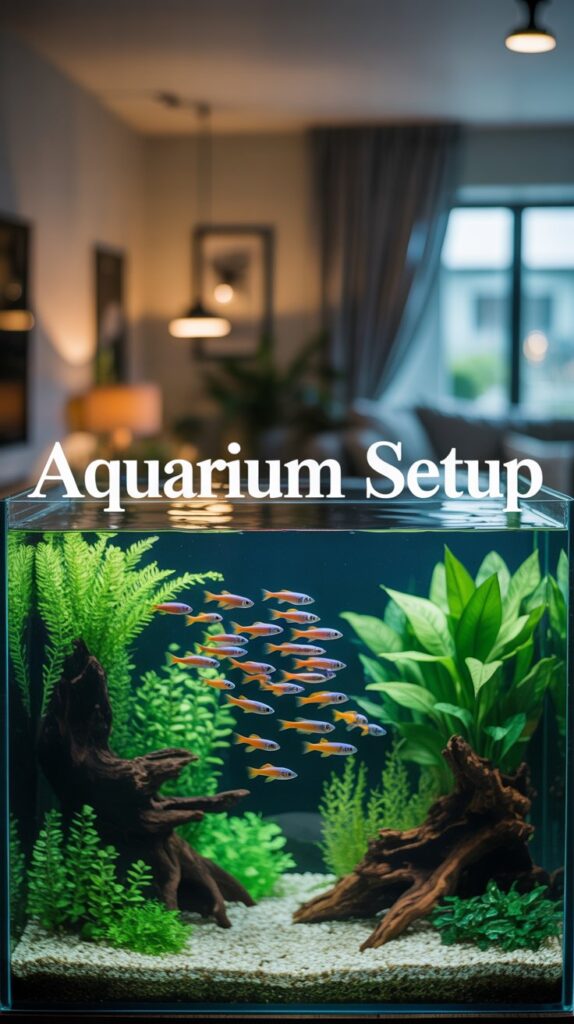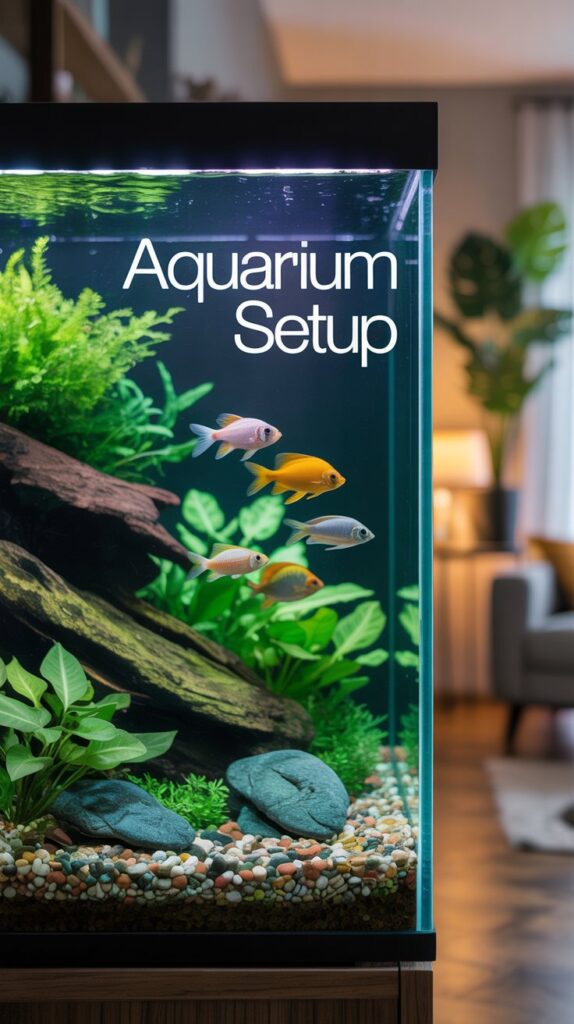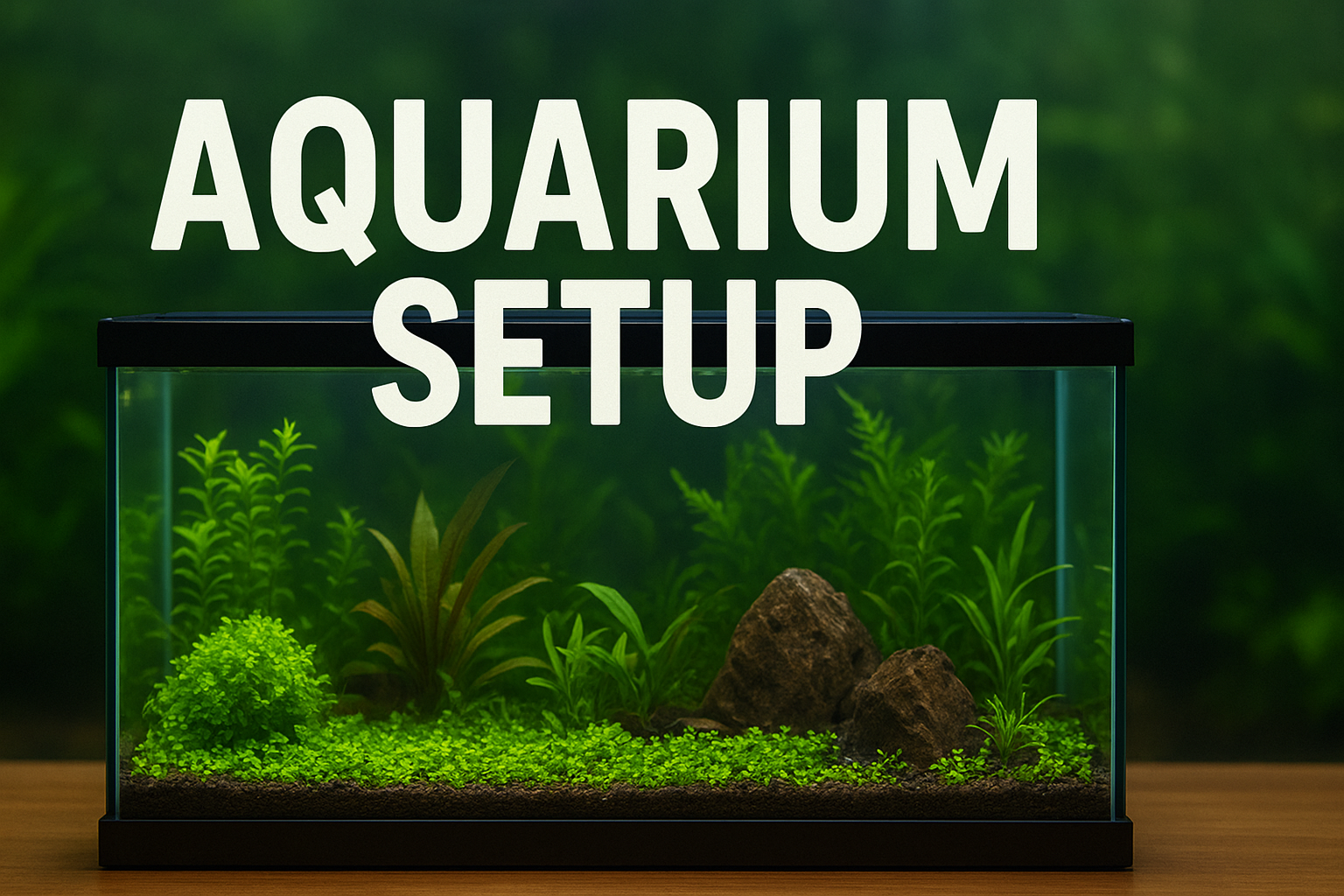Setting up an aquarium is one of the most rewarding hobbies you can enjoy. An aquarium is not just a decorative piece for your home or office—it is a living ecosystem that brings peace, beauty, and relaxation. Whether you are a beginner setting up your first fish tank or an experienced aquarist aiming for an advanced aquascape, understanding proper aquarium setup is essential for the health of your fish, plants, and overall aquatic environment.
This detailed guide will cover everything you need to know about aquarium setup, from choosing the right tank and equipment to selecting fish, aquascaping, and long-term maintenance.
Why Aquarium Setup is Important
Aquarium setup is more than just filling a glass box with water and fish. Proper setup ensures:
- A stable and healthy environment for fish and plants
- Prevention of common issues like algae, diseases, or cloudy water
- Balanced ecosystem with correct filtration, lighting, and water chemistry
- Enhanced beauty through aquascaping and decorations
- Long-term success in fishkeeping without unnecessary stress
Types of Aquariums You Can Set Up

Before starting, decide what type of aquarium you want:
1. Freshwater Aquarium
- Easiest and most affordable for beginners
- Wide variety of fish like guppies, tetras, bettas, and cichlids
- Can include planted aquariums for a natural look
2. Saltwater Aquarium
- More challenging but visually stunning
- Includes reef tanks with corals and marine fish like clownfish, tangs, and gobies
- Requires precise water parameters and advanced equipment
3. Planted Aquarium
- Focuses on live aquatic plants and aquascaping
- Provides a natural ecosystem for fish
- Can be low-tech (simple plants, no CO2) or high-tech (advanced lighting and CO2 systems)
4. Brackish Aquarium
- Mix of freshwater and saltwater
- Designed for fish like mollies, scats, and pufferfish that live in estuaries
5. Biotope Aquarium
- Replicates a natural habitat (Amazon River, African lakes, Asian streams)
- Includes native plants, rocks, driftwood, and fish species
Essential Equipment for Aquarium Setup
To create a healthy and stable environment, you’ll need the following equipment:
- Aquarium Tank – Choose a size that matches your space and experience level. A 20–30 gallon tank is ideal for beginners.
- Stand – A sturdy stand that supports the tank weight.
- Filter System – Keeps water clean and clear. Options include hang-on-back filters, sponge filters, or canister filters.
- Heater – Maintains stable water temperature for tropical fish (24–27°C / 75–81°F).
- Lighting – Provides energy for plants and enhances fish colors. LED lights are energy-efficient and long-lasting.
- Substrate – Gravel, sand, or nutrient-rich soil for planted aquariums.
- Air Pump & Air Stone – Improves oxygen levels and water circulation.
- Thermometer – Helps monitor water temperature.
- Water Conditioner – Removes chlorine and harmful chemicals from tap water.
- Aquarium Test Kit – Monitors pH, ammonia, nitrites, and nitrates.
- Decorations & Aquascaping Materials – Rocks, driftwood, plants, and ornaments.
Step-by-Step Aquarium Setup Guide

Step 1: Choosing the Aquarium Tank
- Larger tanks are more stable and easier to maintain.
- For beginners, a 20–30 gallon freshwater tank is a good starting point.
- Decide the shape: rectangular tanks are easier to clean, while bow-front tanks add visual appeal.
Step 2: Selecting the Location
- Place the aquarium away from direct sunlight to prevent algae growth.
- Ensure the stand and floor can handle the weight.
- Keep it near electrical outlets for equipment.
Step 3: Preparing the Substrate
- Rinse gravel or sand before placing it in the tank.
- Add 2–3 inches of substrate depending on your plants and aquascape design.
- For planted tanks, use a nutrient-rich base layer.
Step 4: Adding Decorations and Hardscape
- Place rocks, driftwood, and ornaments before filling with water.
- Secure decorations to prevent shifting.
- Design your aquascape layout (Dutch, Iwagumi, Jungle, or Nature style).
Step 5: Filling the Tank with Water
- Use dechlorinated water or treat tap water with a water conditioner.
- Slowly fill the tank to avoid disturbing the substrate.
- For saltwater aquariums, mix marine salt to achieve the correct salinity.
Step 6: Installing Equipment
- Attach filter, heater, and thermometer.
- Set up lighting according to your plants and fish.
- Start air pump and CO2 system if required.
Step 7: Cycling the Aquarium
- The Nitrogen Cycle is crucial for fish health.
- Run the aquarium for 4–6 weeks without fish to build beneficial bacteria.
- Test water regularly for ammonia, nitrites, and nitrates.
Step 8: Introducing Fish and Plants
- Add hardy plants like Java Fern, Anubias, or Amazon Sword.
- Start with a few fish to avoid overloading the filter.
- Gradually increase fish population over several weeks.
Choosing the Right Fish for Your Aquarium Setup

Freshwater Fish for Beginners
- Guppies
- Neon Tetras
- Betta Fish (one per tank unless divided)
- Corydoras Catfish
- Mollies and Platies
Saltwater Fish (for advanced aquarists)
- Clownfish
- Gobies
- Damsels
- Tang species
Community-Friendly Fish
- Rasboras
- Swordtails
- Dwarf Gouramis
- Shrimp and Snails (great cleaners)
Common Mistakes in Aquarium Setup
- Adding Fish Too Early – Leads to ammonia spikes and fish deaths.
- Overfeeding – Causes water pollution and algae growth.
- Overstocking – Too many fish stress the ecosystem.
- Ignoring Water Testing – pH, ammonia, and nitrate imbalances harm fish.
- Improper Lighting – Too much causes algae; too little harms plants.
- Neglecting Maintenance – Regular cleaning and water changes are crucial.
Maintenance Tips for a Successful Aquarium
- Weekly Water Changes – Replace 20–30% of water.
- Clean Filter Monthly – Rinse filter media with tank water (not tap water).
- Check Equipment Regularly – Ensure heater, lights, and filter are working.
- Trim Plants – Prevent overgrowth and maintain aquascape design.
- Monitor Fish Health – Look for signs of stress or disease.
- Algae Control – Add algae-eating fish/shrimp and adjust lighting.
Advanced Aquarium Setup Ideas

- Aquascaping Themes – Try Dutch style, Iwagumi, Jungle, or Nature layouts.
- Biotope Setup – Create Amazon, African Rift Lake, or Asian stream habitats.
- Reef Tank – Combine corals, live rock, and marine fish for stunning beauty.
- Paludarium – Mix land and water areas for amphibians, reptiles, and fish.
Conclusion
Aquarium setup is both science and art. A properly set up aquarium not only enhances your living space but also creates a thriving environment for aquatic life. By choosing the right tank, equipment, plants, and fish, and by following proper setup and maintenance practices, you can enjoy a healthy, vibrant, and beautiful aquarium for years to come.
Whether you start small with a freshwater tank or aim big with a saltwater reef aquarium, patience and consistency are the keys to success.
FAQs About Aquarium Setup
Q1: How long should I wait before adding fish to a new aquarium?
You should wait 4–6 weeks to allow the nitrogen cycle to establish before adding fish.
Q2: What size aquarium is best for beginners?
A 20–30 gallon freshwater tank is recommended for beginners as it is easy to manage and stable.
Q3: Can I use tap water in my aquarium?
Yes, but always use a water conditioner to remove chlorine and harmful chemicals.
Q4: Do aquariums need filters?
Yes, filters are essential to remove waste, toxins, and maintain water clarity.
Q5: What is the difference between freshwater and saltwater aquarium setup?
Freshwater tanks are easier and cheaper, while saltwater aquariums require advanced equipment and precise water chemistry.
Q6: Can I put live plants in my aquarium?
Yes, live plants improve water quality, oxygen levels, and add natural beauty.
Q7: How often should I clean my aquarium?
Perform partial water changes weekly and deep clean equipment monthly.
Q8: What fish are good for a community aquarium setup?
Tetras, guppies, rasboras, and corydoras are peaceful and ideal for community setups.
Q9: Do I need a heater for my aquarium?
If you are keeping tropical fish, yes. Coldwater fish like goldfish do not require heaters.
Q10: Can I keep saltwater fish in a freshwater setup?
No, saltwater fish cannot survive in freshwater. Always match the fish species with the correct environment.

